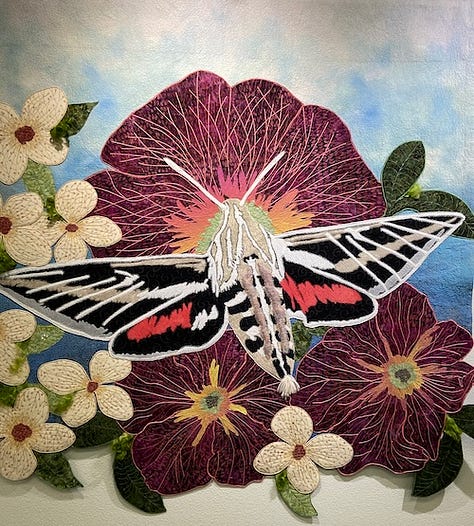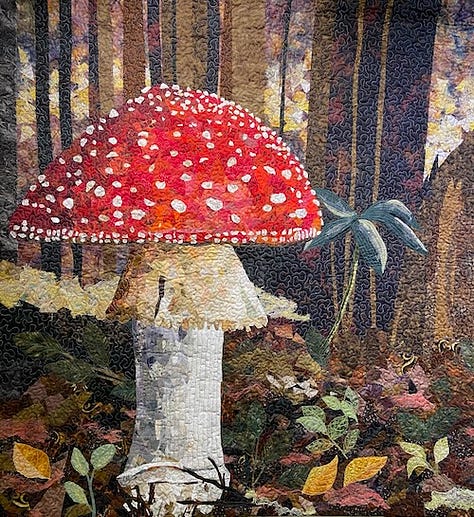Seeking Light, Finding Gratitude
Reading, Writing, Listening, & Eating in the Season of Giving Thanks
I have slowly crawled out of the post-election cave of darkness I fell into—a darkness I hadn’t experienced in many years. I am exiting that place not filled with optimism but with hope and persistence. Still, I can’t help but mourn for the earth, our species and co-species, and our ecosystems as America’s leadership declines in so many ways.
In my nature writing course, after the election of a climate change denier, we wonder if writing about nature has purpose and value.
Are the stories worth telling?
We had our first snowfall, followed by an atmospheric river, the language used by weather experts to describe heavy amounts of rain. A bomb cyclone blew into the PNW west coast, leaving 600,000 people without electricity, hundreds of downed trees, and at least two people killed by falling trees. On my side of the Cascade Mountains, the “nothingness cloud” has returned for its annual early winter visit. Named by a local weather forecaster, the nothingness cloud is a dense fog that hangs low in some parts and completely disappears in others. While driving up my mountain road yesterday, I moved in and out of fog scenes, some so thick that I couldn’t see 30 feet ahead. Our mountains now measure in feet, which is incredibly important as the American West lives with years of accumulated drought.
I am decorating my Christmas tree and making a decorative dried orange garland this weekend, which is what I love most about this winter holiday. The bright lights and shiny ornaments offer a cheerful alternative to the PNW gray. I am ready for merrymaking, crunchy snow walking, and winter’s promise of rest.
Most importantly, I am returning to my daily gratitude practice. I left it at the cave opening, but on my way out, I picked it back up and inserted it back into my heart, just in time for this season of giving thanks.
Gratitude for Readers, Writers, and Storytelling
I must start with my readers: Thank you for reading, commenting, and sharing my newsletters. There’s a lot of competition for your attention, and choosing to spend time reading what I write is the greatest compliment. I am planning some new things for my Substack newsletter in the upcoming year and look forward to sharing them with you.
Since my Nancy Drew pre-teen years, reading has been both my escape and my tool for understanding the world. Substack has become my go-to place for intelligent thinking, creativity, and compassion. There are so many thoughtful, inspiring writers! I read several writers regularly, and I wanted to share specific newsletters that affected me during the last month. Without intention or awareness, I selected essays with persistence as the theme.
Heather Cox Richardson’s Letters From An American
There are good reasons why her newsletter has 1.8 million subscribers. I don’t have a specific essay because all her essays offer a historical understanding of our country's politics. Her bias leans to her beliefs in democratic principles and self-determination. She reminds us how lucky we are to live in a country where we can speak and live freely. She hopes that Americans will wake up and protect those freedoms.
Karen Davis’ Life in the Real World
I drink my first cup of coffee in the morning while slowly reviewing Karen’s photo essays. Her bird photos and writing make me smile. She offers images of a place that I would have never visited. This photo essay on connection and resiliency went straight to my heart.
Susan Tweit’s Practicing Terraphilia
Sandhill cranes are one of my favorite birds. They nest at a nearby refuge, and I once had the unique experience of watching their mating dance at a different wildlife refuge. This post also grabbed my heart and offers a simple message of persistence. Susan is a nature writer who weaves facts and emotions into powerful storytelling. She also writes daily haikus. I discuss her touching memoir, Blessed Birds in this post.
Janiesse Ray’s Trackless Wild
Janiesse lives in southern Georgia, and her writing about Hurricane Helene captured the essence of the force of nature, destruction, and the persistence of nature and community in this series of flash essays. She introduced me to flash essays in a workshop, and I love them! I plan to incorporate flashes in my future writing. Janiesse is also an influential nature writer and offers courses on the craft of writing. I loved her book Wild Spectacle, which I discuss in this newsletter.
Susan Wittig Albert’s Thyme, Place & Story
Susan is a prolific writer, and her Substack is filled with writing on various topics. I discovered her through her delightful series of herbal cozy mysteries, which I started reading in the late 1990s. She recently published a fascinating historical fiction on Georgia O’Keefe (Someone Always Nearby), which used biographies and personal correspondence to explain the complicated relationship between O’Keefe and Maria Chabot. (My thoughts on this book are in this post.) Susan founded the Story Circle Network, an organization that encourages women to tell their stories.
This week, Susan announced a Guerilla Readers book club that will “challenge us to reflect from a variety of perspectives on current events in this country: where we are and what it looks like, how we got here and where we’re going, what people are doing about it.” Books for January and February have already been selected. Join us for some deep dives into essential topics!
November’s Reads
I escaped into fiction during this month of seasonal and emotional darkness.
The Heiress by Rachel Hawkins (Mystery thriller/audio)
It was darker than I expected (that’s the mystery part) and had some unusual twists.
The God of the Woods by Liz Moore (Mystery/Audio)
It started slowly for me, and I almost gave up, but 500 pages later, I was happy to have read it. Characters: Two siblings, a wealthy family, an elite summer camp, a small town. A unique twist at the end.
The Drowning Woman by Robyn Harding (Psychological thriller/audio)
I am drawn to fiction books set in the PNW because I know this region. This book was full of twists until the end, and her characters were believable.
Currently Reading
The Entire Sky by Joe Wilkins (novel)
I have read about half of this book and am reading it slowly because the writing is terrific. The story is compelling, and the characters are dimensional. Though fiction, I am taking notes of his precise and unique use of verbs and nouns, metaphors, and similies.
Lady Tan’s Circle of Women by Lisa See (historical fiction/audio)
From the publisher: A captivating story of women helping each other, Lady Tan’s Circle of Women is a triumphant reimagining of the life of one person who was remarkable in the Ming dynasty and would be considered remarkable today.
As part of my early training in herbalism, I did a 101-level study of Traditional Chinese Medicine (TCM) and found it fascinating. I am enjoying the TCM discussion in the book. Women's cultural limitations and expectations in the 15th century…not so much.
What Wildness is This: Women Write About the Southwest (an anthology)
I lived in the American Southwest for two years and visited annually for 40 years because my family lived in AZ. I slowly fell in love with the desert landscape (but not the heat). I started reading this collection of essays and poetry months ago but got sidetracked. It is a beautiful collection of writing about place.
Calm Christmas Podcast & Winter Writing Sanctuary
UK writer Beth Kempton has recorded her fourth season of the Calm Christmas podcast, and the first two episodes are now available. She is a “Keeper of Christmas,” a descriptor I have adopted for my own secular love of Christmas. She reads poetry and short essays and offers recipes, crafting ideas, gift-giving tips, self-care recommendations, and simple ways to celebrate this holiday. You may enjoy this podcast if you are a Keeper of Christmas traditions.
She also offers a free Winter Writing Sanctuary course, which includes nine days of daily readings and prompts. I have participated in this course in previous years, and it is a great way to contemplate a season.
Thanksgiving, Food, & Farmworkers
It’s the week of the annual American Thanksgiving, a national holiday based on a mythologized history that’s mostly forgotten as people celebrate with gatherings, food, and football. Many years ago, I abandoned the ritual of preparing lavish feasts and adopted a simpler ritual of baking bread and pumpkin pie and making a big pot of soup for the day. The truth is I never liked the modern Thanksgiving menu of dry turkey, mushy green bean casserole, and sweet potatoes with that weird marshmallow topping.
Some years, I head to a nearby wildlife refuge for a quiet walk and then spend the day reading (no football fans here). This year, we are attending a family potluck, offering much of the traditional menu. I am bringing whole and jellied cranberry sauce (I have learned that people are very particular about their preferences) and this Brussels sprout salad.
Chances are that much of the food Americans eat this week (and throughout the year) was planted, harvested, slaughtered, and processed by migrant farmworkers. There are approximately 2 million farmworkers in the corporate agricultural system, and at least half are undocumented migrants. The majority live in cheap and crowded housing, have little to no access to healthcare, are regularly exposed to toxic pesticides and dangerous work conditions, and are subject to a lack of humane workplace protections. If workers are undocumented, they are often victims of exploitation, such as lower wages and physical abuse. Let’s thank our farmworkers every day and stand up for their right to be treated humanely.
And More Gratitude…
I stopped at the library yesterday and discovered a beautiful quilt art display in the gallery. More gratitude for the artists in the world.



Next weekend, I have a fun holiday-sharing activity in mind, so watch for my newsletter. Wishing a peaceful week to all,
Sue
Thank you for being here. If you’d like to support my work, you can do so by:
Liking this post so that others are encouraged to read it.
Leaving a comment.
Sharing this post via email or on social media.
Taking out a paid subscription to this Substack.
Your comments are always appreciated!








Thanks for your thoughts. Yes, writing about nature as you do is critical because of how it inspires people to get outside and develop stronger connections to place. And through those we can remain committed to protecting this beautiful world.
Daily gratitude is a daily ritual for me as well. I'm still in and out of the dark cave.